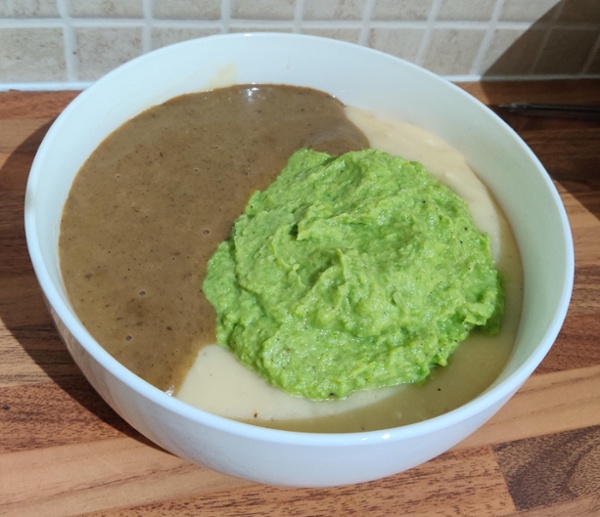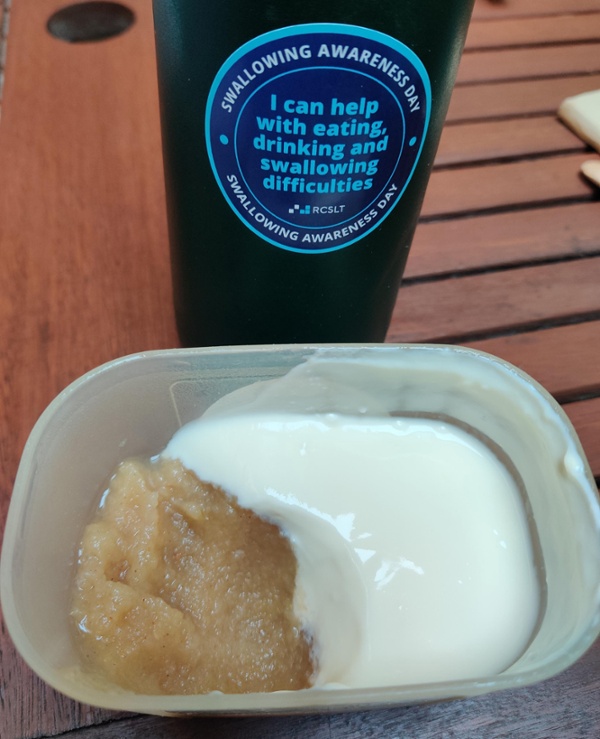Staff try pureed diet to find out what life is like for their patients

Swansea Bay staff went above and beyond to gain a new insight into their patients’ lives by spending two days eating pureed food.
Head and neck clinical nurse specialists Sharon Kincaid and Hayley Davies, along with speech and language therapists Jemma Pullen and Eluned Llewellyn Morgan, and Macmillan nutrition clinical nurse specialist Llynos Webster, wanted to find out what it’s like to live with dysphagia, or problems with swallowing.
Patients with dysphagia often need their food texture to be modified by being blended or pureed, but it’s not as simple as it sounds.
Causes of dysphagia are common and may include stroke, head and neck cancer, Parkinson’s disease or learning disabilities.
Speech and language therapists (SLTs) assess individual needs and then recommend a food texture based upon a framework called the International Dysphagia Diet Standardisation Initiative, which sets out precise textures according to how significant an impairment is.
Because difficulty with swallowing can lead to choking and aspiration of food (when it enters the airway, potentially causing infection), it is essential guidelines on texture are followed precisely.
In hospitals, SLTs work closely with ward nurses, hostesses and the kitchen to have pre-made puree meals provided to inpatients. For those in the community, puree meals are also available from well-known ready-meal food delivery services.
But it’s one thing to know the theory and another to live with the day-to-day reality of dysphagia, which is why the Swansea Bay group decided to undertake the pureed food trial to gain a greater understanding of their patients’ lived experience.
“I think the experience has really made all of us appreciate the effort patients and their families put in to living on a pureed diet,” said Hayley Davies.
“And going forward, this will really help guide us with how to discuss and help our patients make the best adjustment to pureed meals.
“It’s one of those things that is often easier said than done. There is extra work that goes into a pureed diet. There’s the preparation time and getting the texture of the food exactly right. It can definitely be done – our patients obviously don’t have a choice. But it does require some planning and extra time and also potentially equipment that not everyone always has access to, like a blender.”
The trial group were given a selection of recipes and tips to prepare their own pureed meals in addition to samples of pre-prepared options from Wiltshire Farm Foods.
Many foods can be adapted to a puree consistency. For example, to make an IDDSI Level 4 Puree meal, the food needs to be cooked until soft and then blended in a machine with added moisture and/or passed through a sieve.
Pictured below: a pureed meal of butter beans, leeks, peas and gravy
Numerous commonly available ready-made snacks are also puree consistency, including smooth custards, apple puree/compote pots, mousses, smooth/set yoghurt and fromage frais, cream cheese, pate and hummus.

“On the first day I was really hungry when I came to eat lunch, because I’d not had time to make breakfast - which I’d planned to be porridge - as my daughter was unwell,” added Hayley.
“Normally I’d grab a piece of toast and eat in the car but that wasn’t an option. So I just skipped having breakfast.”
When it came to lunch, the sandwich box staples of sandwich or baguette, or even a salad, were clearly not an option.
“I didn’t try the pre-prepared meals, so I effectively made foods I would have eaten anyway and then blended them,” said Eluned Llewellyn Morgan.
“But one of my conclusions from the experience was the amount of washing up involved.
“You can chuck everything into the blender all together, which is the easiest option but you’ll probably always end up with a brown or grey mush, which is not as good from an appearance perspective.
“So I did things separately, which looked nice and was more appealing because of the different colours but it did create a lot of washing up. Also, by the time I’d prepared all the elements of the meal, some of it had gone cold, which can change the texture. For example, like when skin forms on custard.

“The advantage of preparing my own food was I could batch cook and have something for my lunchbox the following day but it was difficult to stop the different ingredients getting mixed together. The answer to that problem would be moulds, which would have been a help and are readily available.
Pictured: Pureed stewed apples and yoghurt
“But it was tasty. The texture, of course, was different but the flavours were as good as ever. So the experience will really help me when it comes to those conversations with patients, about explaining what worked for me and could then work for them.”
The trial group also noted that getting portion sizes correct for each individual on a pureed diet can also be a learning process.
“Because you are adding liquid to the food, you need to re-learn how to portion your meals. It clearly can be done but it’s another consideration we’re more aware of now,” added Eluned.
“I found if I prepared my normal portion first before blending it, it was easier to get the right amount as opposed to guessing afterwards. Again, this is advice we can now offer our patients, which is really helpful.”
Another plus is the trial focused the group on trying to find some solutions for another issue facing people living on puree diets – how to enjoy a meal in a restaurant.
“Some of our patients had previously shared information on restaurants that will puree meals,” said Sharon Kincaid.
“So we’re hopefully going to build a database of suitable places to eat out. It would be a case of ringing ahead but it’s so important for people to feel their lives are not restricted and we know there are places willing to assist, which is great. It may not always be suitable for some of the more pureed textures but at least this is a positive step.”
As for what proved to be the favourite, flavoursome dish during the team’s two day test, there was one clear winner.
“Jam sponge and custard was the highlight for all of us,” added Sharon.
“I think that’s because it wasn’t too far away from what you’d expect from jam sponge and custard.
“What we learned was breakfast and puddings are easier than perhaps the savoury, lunch or dinner meals. You’ve got to put a lot of flavour into a blended diet. But at least by undertaking this trial, I think we now have some new ideas about what might work for people, which makes it really worthwhile.”
Rydym yn croesawu gohebiaeth a galwadau ffôn yn y Gymraeg neu'r Saesneg. Atebir gohebiaeth Gymraeg yn y Gymraeg, ac ni fydd hyn yn arwain at oedi. Mae’r dudalen hon ar gael yn Gymraeg drwy bwyso’r botwm ar y dde ar frig y dudalen.
We welcome correspondence and telephone calls in Welsh or English. Welsh language correspondence will be replied to in Welsh, and this will not lead to a delay. This page is available in Welsh by clicking ‘Cymraeg’ at the top right of this page.